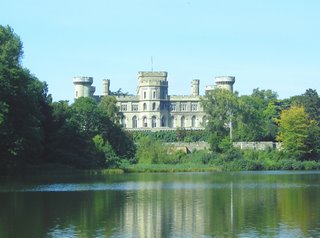Eastnor Castle across the lake
I was fortunate enough to have spent much of my early childhood exploring and adventuring in the castles extensive grounds, dark winding stairways, forgotten attics and grand halls, or playing toccata and fugue very poorly on the chapels harmonium. The castles main rooms much of which are now open to the public have been redecorated many times through the castles life. In 1849 the 2nd Earl commissioned AWN Pugin to decorate the Gothic Drawing Room which he did after completing work at the House of Lords. The 3rd Earl Somers, Charles, undertook many of the embellishments of the castle during the 1860’s and 70’s and was at the forefront of contemporary taste. Charles also collected many classical antiques and art including the extensive collection of medieval armour and was also responsible for the planting of the beautiful arboretum.
The arboretum summer house
During the agricultural depression of the 1930’s the estate began to struggle financially and in September 1939 traditional aristocratic life at the castle came to an end and it was offered to the Australian High Commission in case they needed to leave London during the Blitz. The family moved first to a cottage in the grounds before returning to smaller private rooms of the castle where they lived quietly, directing their energies into agriculture and modernizing estate properties. The castle began to fall into disrepair and life proceeded in relative discomfort, trekking 50 yards from the bedrooms to the nearest bathroom, patrolling for roof leeks with buckets when it rained, collecting wood and clearing the roofs of snow.
Eastnor Castle from Ragged Stone Hill
When Hon. Elizabeth Somers Cocks died in 1986 her eldest son James wanted to live there and his then wife Sarah put unimaginable effort and thought into restoring the castle to its former glory, much of which is exactly as found today. With its intriguing history, expansive grounds and lake, great halls, dining room, drawing room, libraries, saloon, chapel and plethora of grand bedrooms Eastnor castle is a fascinating and beautiful stately home to visit and enjoyable for all the family, young and old alike.
As well as being open to the public





No comments:
Post a Comment